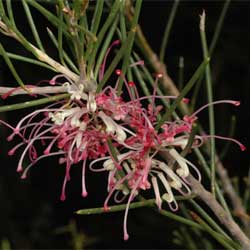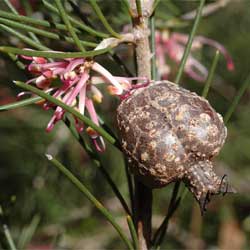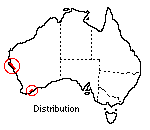Hakea verrucosa
 |
 |
Warty-fruited Hakea
Warty-fruited Hakea is an interesting shrub from open, sandy and gravelly habitats in Western Australia, not commonly grown in gardens in eastern Australia. Its attractions are winter flowering and compact healthy growth of medium size.
 At best the shrubs are massed with delicate flowers among the sharp spines,
stemless on the hard wood. They are narrowly tubular with long styles, scentless
and waxy, hanging softly in clusters of several flowers or fanning out almost
in a wheel 6 cm across. The flower colour is subtle and difficult to record,
as in many other members of the plant family Proteaceae. It is a suffused mixture
of ruby reds and light purples*, which may chill
to cold mauves in a severe wintry spell. Bees are frequently seen visiting the
flowers.
At best the shrubs are massed with delicate flowers among the sharp spines,
stemless on the hard wood. They are narrowly tubular with long styles, scentless
and waxy, hanging softly in clusters of several flowers or fanning out almost
in a wheel 6 cm across. The flower colour is subtle and difficult to record,
as in many other members of the plant family Proteaceae. It is a suffused mixture
of ruby reds and light purples*, which may chill
to cold mauves in a severe wintry spell. Bees are frequently seen visiting the
flowers.
The leaves are thick spines 6 cm long resembling those of other 'needle' Hakea species and very healthy, impervious to attack by most pests and diseases. Because of its prickly character, a safe garden position should be chosen and the species makes an excellent barrier as a lightly trimmed hedge to 2 m high if desired.
The foliage has a pleasant appearance with its healthy, mid-green colour and lighter tip growth in summer and autumn.
These are upright, rigid shrubs with several thick main branches at ground level. These branch densely at short intervals, aided occasionally by frost killing a few half-ripe tips which acts as a light trimming. In colder parts it could be advisable to cover young plants on winter nights. Sacking can be supported on stakes, clear of the plant, for the cold reaches any part of the plant where the sacking rests.
Plants can flower while young and specimens have been observed flowering at 30 cm high when about a year old. On a watered plant the season can start in late April and last till September; it is at its best during a long period between June and August. In extreme cold with dryness the display is sparse or absent. A few small woody fruits are seen some years.
Apart from seed, half-ripe cuttings can be used in propagation. The species is not common in the nursery trade, but can be bought from some specialist nurseries. Soils should be reasonably well-drained and plants should be placed in sunny positions for good flowering.
The shrubs usually recover from drought and also from spells of water-logging. Following long rainy spells, die-back, attributed to root-rot fungus, has been noticed. This had a similar trimming affect to frost and did no permanent damage to established plants. This is not a good cut flower. The stiff pieces are hard to arrange and the colour, so bright in the winter garden, seems cold indoors.
Text by ANBG staff (1974)
*RHS CoIour Chart, 1966,
red-purple 61A/B with styles red-purple 64C.
Name meaning: Hakea verrucosaHakea - after Baron von Hake, an 18th century German patron of botany; verrucosa - warted, alluding to the woody fruits |
![An Australian Government Initiative [logo]](/images/austgovt_brown_90px.gif)

